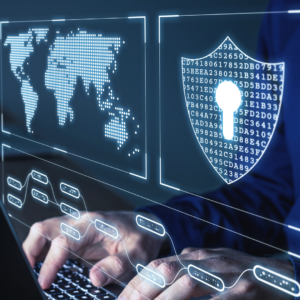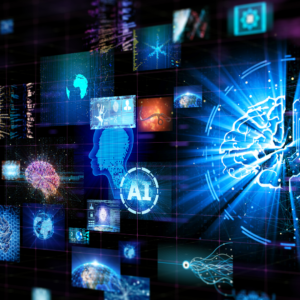The buzz around artificial intelligence has hit a crescendo, with the “AI-powered” label appearing everywhere. Yet, beneath the surface of groundbreaking technology lies a complex duality between security and threat. This begs an era-defining question: How has generative AI affected cybersecurity? While AI promises unprecedented advancements in threat detection and response, the very capabilities that shore up our defences are simultaneously being weaponised by cybercriminals, creating a high-stakes battle in the digital world.
Consider this: by 2024, cybercrime is projected to inflict a staggering $9.5 trillion in damages globally. This immense financial incentive fuels the rapid evolution of cyber threats, with AI acting as a key catalyst in developing more sophisticated and far-reaching attacks. As the digital and physical worlds become increasingly integrated, the potential consequences of these AI-enhanced cyberattacks extend far beyond mere financial losses, threatening critical infrastructure, national security and personal well-being.
However, this narrative is not one of pure threat. AI also presents a powerful arsenal against those who would seek to do harm. It excels at swiftly analysing vast datasets to identify subtle anomalies, enabling real-time threat detection and response. The integration of AI in cybersecurity, therefore, represents a critical and evolving frontier in our efforts to safeguard the digital landscape.
Here, we examine the threats and opportunities on balance and consider, what are the advantages and disadvantages of AI in cybersecurity?
Table of Contents
How AI has impacted cybersecurity
The integration of artificial intelligence has profoundly altered the cybersecurity landscape, introducing both powerful new tools and sophisticated new threats. While AI arms defenders with innovative capabilities, it also presents novel challenges and amplifies existing vulnerabilities.
Technology-driven vulnerabilities arise directly from AI’s inherent functions. For example, AI facilitates automated vulnerability discovery, enabling cyber criminals to scan systems at speeds and scales previously unattainable, exposing weaknesses with ruthless efficiency. Equally, AI can generate malware that adapts and evolves to evade detection by security software, making it significantly harder to identify and neutralise.
Data poisoning is another strategy that preys on AI’s fundamental characteristics. It involves attackers deliberately corrupting data used to train AI models, causing the AI to make errors or behave in a harmful way. Adversarial AI attacks employ a variation on this approach, crafting specific inputs designed to deceive the AI, resulting in misclassification or incorrect actions. Both types of attacks highlight a fundamental weakness: AI’s reliance on data integrity and predictable inputs, a weakness that malicious actors can exploit to undermine even the most sophisticated systems.
Nonetheless, many of the threats we face are far from the science-fiction-esque realms of advanced technologies. When considering how generative AI has affected cybersecurity, the reality is that AI exacerbates human-driven vulnerabilities. AI’s capacity to generate highly convincing phishing emails is a prime example, turning social engineering into a far more potent weapon. Traditional phishing relied on easily detectable flaws; however, AI-generated messages are so believable that they can deceive even the most vigilant users. Similarly, its ability to accelerate password guessing and bypass CAPTCHAS undermines authentication systems, exploiting the inherent weaknesses in human password creation and verification processes.
Beyond these immediate threats, the integration of AI introduces broader organisational risks. The potential for employees to inadvertently mishandle sensitive data when using AI tools is a significant concern. When professionals upload confidential financial or employee information to AI platforms, the risk of data exposure escalates dramatically. This highlights the critical need for robust governance and training, striking a balance between the benefits of AI and the imperative to protect sensitive information from both technological exploits and human error.
The cautionary tale of DeepSeek
To better understand how generative AI has affected security, let us turn to the cautionary tale of DeepSeek. The rapid ascent of the Chinese generative AI platform has been shadowed by significant security concerns, particularly in light of recent allegations suggesting the potential theft of proprietary AI models from OpenAI. Considering that DeepSeek’s core intelligence may have been illicitly obtained, this controversy adds a critical layer to the existing risks associated with the platform,
Naturally, this raised serious questions about the platform’s security foundation and the potential for undisclosed backdoors or vulnerabilities embedded within the stolen models. This alleged intellectual property infringement not only casts a pall over DeepSeek’s ethical standing but also amplifies the anxieties surrounding its security architecture.
Even prior to these allegations, DeepSeek presented a concerning security profile. Reports indicated that user data was stored on servers within China, subjecting it to Chinese legal frameworks that necessitate cooperation with state intelligence agencies. This raised immediate red flags regarding data privacy, especially considering DeepSeek’s extensive data collection practices, which reportedly encompassed user inputs, device specifics, network information, and even keystroke patterns.
Furthermore, independent security researchers uncovered a series of technical weaknesses within the DeepSeek application itself. These included the use of weak encryption protocols, the potential for SQL injection attacks, and the presence of hardcoded encryption keys – all of which could be readily exploited by malicious actors seeking to compromise user data or gain unauthorised system access. The discovery of links to China Mobile, a company previously flagged for national security risks in the United States, and embedded code from ByteDance further fuelled suspicions about potential undisclosed data-sharing practices.
The confluence of data privacy risks stemming from its operational jurisdiction, technical vulnerabilities within the application, and a demonstrably weak defence against malicious prompting, all now potentially exacerbated by the shadow of stolen AI models, paints a deeply concerning picture of the security risks associated with DeepSeek. The implications extend beyond individual user privacy to broader cybersecurity concerns, highlighting the need for extreme caution and thorough scrutiny of this rapidly adopted platform.

The integration of AI in cybersecurity, represents a critical and evolving frontier in our efforts to safeguard the digital landscape.
How is AI used in cybersecurity?
While the preceding discussion has illuminated the darker potential of artificial intelligence, the narrative is far from one of pure peril. Indeed, AI holds a profound and transformative promise for fortifying our digital frontiers. It moves beyond mere speed and efficiency to fundamentally reshape how we understand, anticipate, and neutralise threats in an increasingly complex digital battlefield. Let’s look at the possibilities.
Fortifying digital defences with speed and precision
Artificial intelligence’s primary strength lies in faster and more accurate threat detection and response. AI-powered systems utilise advanced machine learning to analyse vast amounts of data in real time, allowing for the swift identification of unusual network activity that could indicate a cyberattack. This, in turn, enables proactive measures to be taken before damage occurs.
Furthermore, AI can automate routine security tasks, such as patching software and updating defences against known weaknesses, thereby reducing the time it takes to address potential vulnerabilities and minimise exposure.
Enhanced accuracy and efficiency
Compared to traditional security methods, AI-driven cybersecurity offers notably improved accuracy and efficiency. These systems can scan numerous devices for vulnerabilities much faster than human analysts, leading to quicker identification and resolution of potential threats. For example, zero-trust security frameworks assume no user or device can be trusted by default, requiring strict verification for every access request. AI enhances this by automating access control and continuously assessing risk.
Moreover, AI excels at recognising complex patterns that might be missed by human observation, resulting in more effective threat detection and a reduction in false alarms. This allows security teams to focus on genuine threats, optimising their resources and improving overall security posture.
Scalable and cost-effective
AI-powered tools also provide greater scalability and potential cost savings for cybersecurity operations. By automating time-consuming tasks such as monitoring security logs and analysing network traffic, AI frees up human security professionals to concentrate on more complex and strategic issues. Additionally, AI can process enormous volumes of data rapidly and accurately, enabling organisations to identify and respond to threats more efficiently without necessarily requiring significant increases in personnel or infrastructure.
The indispensable role of cybersecurity expertise
The ascent of artificial intelligence has fundamentally shifted the demands placed on cybersecurity. While AI offers powerful defensive capabilities, the emergence of AI-driven attacks necessitates a parallel evolution in human expertise. Moreover, the rising cost of cyberattacks makes proactive investment in cybersecurity expertise essential. Companies that fail to prioritise the hiring and retention of skilled cybersecurity professionals are increasingly vulnerable to these costly incidents.
Counteracting sophisticated threats that leverage machine learning, natural language processing, and automation requires professionals possessing a deep understanding of both cybersecurity principles and the intricacies of AI technologies. These experts are crucial not only for identifying and mitigating novel AI-powered attacks but also for developing and maintaining the AI security systems designed to defend against them.
Their specialised knowledge forms the bedrock of a robust security position in this increasingly complex environment. Consider new AI malware that adapts its code to bypass standard antivirus software; cybersecurity experts with both malware and machine learning skills become crucial. They can analyse the AI within the malware to understand its adaptation, identify its learning, and then create new AI detection tools that recognise these dynamic behaviours, effectively neutralising the threat. Their combined knowledge is key to countering such advanced attacks.
Beyond simply reacting to threats, skilled cybersecurity professionals play a vital role in ensuring the ethical and robust deployment of AI security systems themselves. As AI algorithms become more integrated into defensive strategies, it is imperative to have experts who can identify and address potential biases within these systems, preventing unintended discriminatory outcomes or vulnerabilities. Furthermore, these professionals are essential for ensuring the resilience and reliability of AI security tools, continuously testing their effectiveness against evolving attack vectors and implementing best practices to maintain their integrity.
Investing in a knowledgeable and capable cybersecurity team, equipped to handle both traditional and AI-driven threats, is not merely an expense but a strategic imperative for mitigating risk, protecting valuable assets, and ensuring the long-term viability of the organisation in the AI era.
The human shield in the age of AI
The ability to decipher the nuances of an AI-driven attack, anticipate an adversary’s next move, and develop innovative defence strategies is a uniquely human endeavour. Artificial intelligence is indeed a powerful tool, but its ultimate impact on cybersecurity remains firmly in human hands. While AI can automate tasks, accelerate analysis, and enhance threat detection, it cannot replace the critical thinking, ethical judgment and adaptive ingenuity of skilled cybersecurity professionals. Therefore, the most crucial investment in cybersecurity’s future is not solely in AI technology itself, but in cultivating the expertise of those who can wield it responsibly and effectively. Organisations must prioritise building knowledgeable and capable cybersecurity teams equipped to handle both traditional and AI-driven threats. By doing so, they can ensure that humanity remains the master of its technological creations, leveraging AI for the betterment of digital security and not its detriment.
To stay ahead of AI-driven cyber threats and build robust defences, consider bringing in top-tier AI cybersecurity talent for your security team. A skilled external professional can help you develop the bedrock for future initiatives and implement cutting-edge security strategies. Secure your organisation’s future – connect with leading AI and cybersecurity experts today to proactively mitigate emerging threats.
Eusebi is Co-Founder and CEO at Outvise, with a demonstrated history in the management consulting industry. He's a seasoned entrepreneur with a strong background in Business Planning, Entrepreneurship, Strategic Partnerships, Business Transformation, and Strategic Consulting.




No comments yet
There are no comments on this post yet.